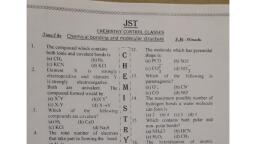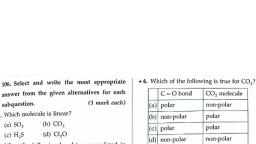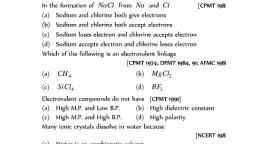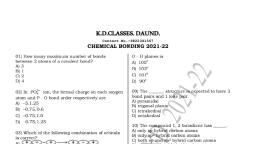Question 3 :
In a multi-electron atom, which of the following orbitals described by the three quantum numbers will have the same energy in the absence of magnetic and electric fields?<br>(i) {tex} n = 1 , l = 0 , m = 0 {/tex} <br>(ii) {tex} n = 2 , l = 0 , m = 0 {/tex} <br> (iii) {tex} n = 2 , l = 1 , m = 1 {/tex} <br> (iv) {tex} n = 3,1 = 2 , m = 1 {/tex} <br> (v) {tex} n = 3 , l = 2 , m = 0 {/tex}<br>
Question 11 :
The correct occlusion order for<img style='object-fit:contain' src='https://storage.googleapis.com/teachmint/question_assets/JEE%20Main/5e79830dadb2ea6185a76397' height='20' width='21' >by the following is -
Question 12 :
Assuming that Hund's rule is violated, the bond order and magnetic nature of the diatomic molecule {tex} \mathrm { B } _ { 2 } {/tex} is
Question 13 :
Which of the following commonly forms ionic compounds as a $-1$ anion?
Question 15 :
An ionic bond A+ B- is most likely to be formed when :
Question 17 :
A square planar complex is formed by hybridisation of which atomic orbitals?
Question 18 :
Which one of the following molecules is expected to exhibit diamagnetic behaviour?
Question 20 :
The maximum number of H-bonds a water molecule can form are
Question 21 :
The shape of water molecule which should be tetrahedral has a bent or distorted tetrahedral shape with a bond angle <img style='object-fit:contain' src='https://storage.googleapis.com/teachmint/question_assets/JEE%20Main/5e79829aadb2ea6185a762a6' height='21' width='41' >. What could be the reason for this?
Question 22 :
During the formation of sodium chloride, sodium transfers one electron to chlorine to attain the configuration of which noble gas?
Question 24 :
Which one of the following pairs of molecules will have permanent dipole moments for both members?
Question 25 :
Which of the following ions have zero value of magnetic moment ?





























